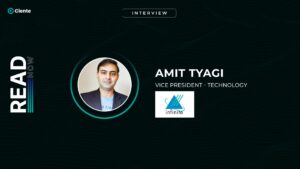Congratulations on your new role as AVP- Customer Success. Could you talk about your current responsibilities and what your 30-60-90 looks like?
Thank you Suruchi.
As the AVP of Consumer Success and Insights Mining at AGL, my responsibility is to build a Center of Excellence (CoE) for data analytics & consulting project implementation. To do this, I need to build a team and bring in new business to drive growth for the organization. It’s crucial for me to have a deep understanding of the organization’s data consulting and analytics capabilities, as well as the clients’ needs and requirements.
Once I identify gaps in expertise, I work with the leadership team to develop a roadmap for building the CoE. I also develop a marketing and sales strategy to promote the CoE and the organization’s capabilities.
My goal is to position the organization as a leader in the data consulting and analytics industry by building a strong team, bringing in new business, and developing cutting-edge technologies.
I have developed a 30-60-90 day plan to help me achieve my goals of building a Center of Excellence (CoE) for data consulting and analytics project implementation, building teams, bringing in new business, and driving the growth of the organization.
In the first 30 days, I plan to conduct a thorough assessment of the organization’s data consulting and analytics capabilities, identify gaps in expertise, and develop a roadmap for building the CoE. I will also prioritize the hiring of key team members to strengthen the team’s capabilities.
During the next 30 days, I will focus on building relationships with clients, understanding their needs and requirements, and developing customized solutions to meet those needs. I will also develop a marketing and sales strategy to promote the CoE and the organization’s capabilities.
In the final 30 days, I will continue to build the team, bring in new business, and focus on the development of a customer data platform that can extract insights from data in real-time. I will also work closely with data scientists and engineers to develop cutting-edge technologies that will position the organization as a leader in the data consulting and analytics industry.
How does a CDP work?
A Customer Data Platform (CDP) is a software that aims to create a seamless experience for customers by gathering, organizing, and managing data from different sources. The goal is to gain a comprehensive understanding of each customer and deliver personalized experiences across various platforms. The CDP uses advanced data management techniques to help businesses understand their customers’ needs and preferences. The data for the CDP comes from various sources like social media, email campaigns, and other sources, including the company’s own website or mobile app.
By integrating all the data sources, the CDP creates a unified profile of the customer, which can inform marketing and sales activities. A notable feature of the CDP is the use of advanced analytics and machine learning algorithms to gain insights into customer behavior, preferences, and needs. This information allows businesses to provide personalized experiences like recommending products or services based on a customer’s browsing history and purchase behavior.
Furthermore, the CDP enables businesses to manage customer experiences across different platforms such as email, social media, mobile apps, and other touchpoints. This feature ensures that every interaction between the business and the customer is tailored to their preferences and interests, leading to better engagement and increased sales.
In conclusion, a Customer Data Platform is a crucial tool that empowers businesses to understand their customers better and deliver personalized experiences that foster loyalty and growth. The CDP provides valuable insights into customer behavior and preferences, allowing businesses to tailor their interactions accordingly and enhance customer satisfaction.
Why should businesses invest in building a MarTech stack?
Investing in a Marketing Technology (MarTech) stack can be a valuable decision for businesses that want to enhance their marketing efforts. Such a stack comprises a range of marketing technologies that can automate, measure, and analyze marketing campaigns, enabling businesses to deliver personalized and targeted experiences to their customers.
The primary advantage of a MarTech stack is the ability to streamline marketing efforts by automating tasks such as email campaigns, social media scheduling, and content management, thus enhancing efficiency and saving time. A MarTech stack can also help businesses measure the effectiveness of their marketing campaigns by providing data-driven insights that can help optimize their efforts.
Another key benefit of a MarTech stack is its ability to deliver a seamless experience for customers through personalized targeting and advanced analytics, which can improve engagement and drive conversions.
Overall, investing in a MarTech stack can help businesses improve their marketing ROI and gain a competitive edge in their industry by automating tasks, measuring effectiveness, and delivering personalized experiences.
What are the must-have features of a CDP platform?
A Customer Data Platform (CDP) is an essential tool for businesses looking to create a unified customer profile and deliver personalized experiences. To maximize the benefits of a CDP, it’s essential to choose a platform that has the right features. Here are some must-have features of a CDP platform:
Data Integration: A CDP should be able to collect and integrate data from various sources, including first-party and third-party data.
Advanced Analytics: A CDP should use advanced analytics and machine learning algorithms to analyze customer data, providing insights into customer behavior, preferences, and needs.
Personalization: A CDP should enable businesses to deliver highly personalized experiences to customers, based on their preferences and behavior.
Multi-Channel Orchestration: A CDP should enable businesses to manage customer experiences across multiple channels, including email, social media, mobile apps, and other touchpoints.
Data Privacy and Security: A CDP should have robust data privacy and security measures in place to protect customer data and comply with regulations.
A CDP platform with these must-have features can help businesses understand their customers better, deliver personalized experiences, and gain a competitive edge in their industry.
To what extent do CDPs help with first-party data?
CDPs are designed to help businesses collect, integrate, and manage customer data from various sources, including first-party data. In fact, first-party data is one of the most valuable sources of customer data for businesses because it is collected directly from the customers themselves.
CDPs can help businesses leverage first-party data by providing a centralized location for storing and managing this data. By integrating first-party data from various sources, such as a company’s website or mobile app, businesses can gain a better understanding of their customers’ behavior, preferences, and needs.
Moreover, CDPs can help businesses analyze first-party data to gain insights into customer behavior, allowing them to create highly personalized experiences. For example, a CDP might be used to analyze a customer’s browsing history on a company’s website to suggest products or services that may interest them.
Overall, CDPs are extremely beneficial for managing first-party data. By providing a centralized location for storing and managing this data and leveraging advanced analytics and machine learning algorithms, businesses can gain a better understanding of their customers and deliver highly personalized experiences that can drive engagement and sales.
The customer journey isn’t linear anymore. How does a CDP help marketers make the most of each touchpoint?
Marketers face the challenge of delivering personalized and seamless experiences to customers who interact with brands through multiple touchpoints across various channels. However, with the use of a Customer Data Platform (CDP), this problem can be solved.
A CDP is a powerful tool that allows marketers to collect, integrate, and manage customer data from various touchpoints, creating a complete view of the customer. This includes first-party data from a business’s website or mobile app and third-party data from social media and email campaigns. Through advanced data management techniques, a CDP helps businesses understand their customers and deliver personalized experiences across all touchpoints.
Understanding customers is crucial to making the most of each touchpoint. A CDP provides a comprehensive view of the customer, enabling marketers to personalize interactions at every stage of the customer journey. By analyzing customer behavior and preferences, businesses can offer relevant content, offers, and recommendations at the right time and on the right channel.
For instance, a CDP can analyze a customer’s browsing behavior on a website to suggest products or services they may be interested in. Similarly, a CDP can personalize email campaigns based on a customer’s purchase history or engagement with prior emails.
Furthermore, a CDP can help businesses measure the effectiveness of their marketing campaigns and optimize their marketing strategies. By analyzing customer data, a CDP can provide insights into which touchpoints are most successful in generating conversions, helping businesses make informed decisions that improve their marketing efforts.
With a CDP, marketers can confidently deliver a human touch to the customer experience, ensuring that customers receive personalized and seamless interactions across all touchpoints.
Why does it help to be more data-oriented?
Being more data-oriented can have a profound positive impact on individuals and businesses. Here are some key reasons why:
Making informed decisions: Having access to relevant data empowers individuals and organizations to make well-informed decisions. Data can provide valuable insights into customer behavior, market trends, and industry benchmarks, allowing you to make decisions based on facts rather than assumptions.
Identifying patterns and trends: By analyzing data, you can identify patterns and trends that may not be immediately apparent. This can help you uncover hidden opportunities or risks, and make adjustments to your strategies accordingly. By taking a data-driven approach, you can stay ahead of the competition and achieve success in your industry.
Measuring performance: Data can help you track the performance of your business, products, or services over time. By measuring key metrics, you can identify areas for improvement and optimize your operations to increase efficiency and profitability. This helps you stay focused on your goals and achieve greater success.
Personalization: By collecting and analyzing customer data, businesses can deliver personalized experiences to their customers. This can help improve customer satisfaction and loyalty, ultimately leading to increased sales and revenue. A data-oriented approach can help you build stronger relationships with your customers and enhance your brand reputation.
Staying competitive: In today’s data-driven world, businesses that don’t use data effectively risk falling behind the competition. By embracing a data-oriented approach, you can stay competitive and drive success in your industry. By leveraging data to make better decisions, identify opportunities, and optimize performance, you can achieve greater success and make a positive impact in your field.
How is AGL different from its competitors?
AGL is different from its competitors in a few key ways. Firstly, AGL has been operating in the digital transformation space for over 13 years, which has allowed them to build a wealth of experience and expertise in the industry. This experience has enabled them to develop a deep understanding of their customers’ needs and challenges, and to develop solutions that meet those needs.
Secondly, AGL is a data-driven company. They understand the importance of data in driving business value, and they use data to inform their decision-making processes. By leveraging data analytics and machine learning, AGL is able to help its customers make more informed decisions and drive better business outcomes.
AGL is focused on delivering business value to its customers. Rather than just focusing on delivering technology solutions, AGL takes a business value-driven approach. This means that they work closely with their customers to understand their business goals and objectives, and to develop solutions that help them achieve those goals. This approach has helped AGL build long-term relationships with its customers, and has enabled them to deliver real value and impact to their businesses.
In addition to their data-driven approach and expertise in digital transformation, AGL is also known for its expertise in data solutioning and consulting. They have a team of experienced data scientists and engineers who are able to design and implement advanced data solutions that help their customers unlock the full potential of their data. This includes data integration, data warehousing, data analytics, and machine learning. By providing these services, AGL is able to help its customers extract more value from their data, and to use data to drive better business outcomes.
What motivates you in business and life?
I am motivated by the values of innovation, authenticity, mindfulness, joy, and inquisitiveness in both business and life. These values help me to stay true to myself, build authentic relationships with clients, stay focused, bring purpose to my work, and continuously learn and grow in my field. By embodying these values, I aim to make a positive impact on the world around me and create value for my clients.
What do you like the best about the culture at AGL?
What I admire most about the culture at AGL is how it creates a sense of belonging for all employees, regardless of their background or identity. The company’s commitment to inclusivity and equal opportunity means that everyone has an equal chance to succeed, and that diversity is celebrated and valued. The open door policy and flat hierarchy foster an environment of transparency and collaboration, where employees feel comfortable sharing their ideas and contributing to the company’s success. The culture at AGL creates a welcoming and supportive environment where all employees can thrive and reach their full potential.

Nitin Sharma, AVP – Consumer Success & Insights Mining @ Hakuhodo – AGL
Nitin is the AVP for Consumer Success and Insights Mining at Hakuhodo-AGL with expertise in solutions engineering, architecture, and data analytics. His core focus is on helping enterprises maximize ROI through intelligent data analytics and implementing customer data platform architecture for various industries. As a highly skilled digital marketing and transformation strategist, Nitin provides businesses with innovative solutions using his proficiency in various data analytics tools. His passion for delivering exceptional results and unwavering commitment to excellence make him an ideal partner for businesses looking to transform their data into strategic assets.






